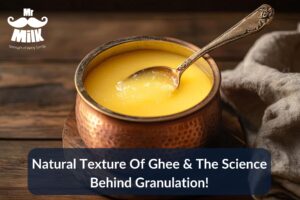Natural texture of ghee and the science behind granulation
Ghee has been a staple in Indian cuisine and traditional home remedies for generations. But did you know that the texture of ghee can vary and that different textures can indicate differences in quality? From smooth and creamy to slightly grainy, the texture of ghee is influenced by various factors.
Let’s explore how ghee gets its unique consistency and the science behind its granulation.

The Various Textures of Ghee:
Once ghee is prepared, its texture is largely determined by how it is stored. Interestingly, the texture of ghee can also be an indicator of its purity and quality. Ghee made from curds cultured directly from cow’s milk, rather than collected cream, tends to have a more pourable and easily digestible consistency.
At room temperature, ghee remains in a liquid state. However, when the temperature drops, it thickens or takes on a semi-solid texture. Even premium A2 Desi Cow Ghee, such as Gir Cow Ghee, displays this characteristic. If the storage temperature fluctuates frequently, the ghee may develop a waxy or pasty consistency.
It’s important to note that while the texture may change, it does not necessarily affect the ghee’s quality.
The Science Behind Granulated A2 Ghee:
A2 ghee is made from A2 milk, which contains a unique type of protein with significant nutritional benefits. Interestingly, mammals, including humans and indigenous cows, naturally produce A2 milk. This is why elders emphasize breastfeeding and the consumption of desi cow milk for infants.
Unlike milk from foreign-bred cows, which contains both A1 and A2 proteins that can be harder to digest, A2 ghee is easier on the stomach and packed with health benefits.
One of the defining features of high-quality A2 Desi Cow Ghee is its granular texture. The presence of medium-sized granules resembling semolina (rawa) is a hallmark of superior quality. At Mr. Milk, we craft granulated ghee by churning fresh curd into butter, which is then slowly clarified.
This traditional method ensures that the ghee retains a balanced composition of saturated and unsaturated fats. The natural crystallization of these fat molecules results in the formation of granules.
Want to experience the rich texture and superior benefits of A2 Ghee? Order Mr. Milk’s Pure A2 Desi Cow Ghee Today!
Why Does Ghee Have Granules?
The granules in ghee primarily consist of palmitic and stearic fatty acids, which offer multiple health benefits. These fatty acids not only help lower LDL (bad cholesterol) levels but also create a protective barrier on the skin, shielding it from pollutants and microbes, thus promoting a clear and healthy complexion.
When producing high-quality granulated ghee, using A2 milk from desi cow breeds like Gir and Sahiwal is key. Interestingly, the diet of the cows influences the granulation of ghee. For instance:
- Medium to large granules in ghee indicate that the cows were primarily grass-fed.
- Larger, more distinct granules suggest that the cows were fed cottonseeds or dry fodder.
Additionally, the cooling process plays a crucial role in the formation of granules. Ghee that is allowed to cool gradually at room temperature forms small to medium-sized granules, whereas ghee that is rapidly cooled right after clarification develops larger granules.
Looking for the finest A2 Desi Cow Ghee made using the traditional Bilona method? Shop Mr. Milk’s Premium Hand-Churned Ghee Now!
For the best Desi Ghee in town, trust Mr. Milk – crafted with care using traditional techniques to retain all the essential nutrients and immunity-boosting properties. Whether for cooking or skincare, our pure A2 Desi Cow Ghee ensures you get nothing but the best!
Embrace the purity of tradition and bring home Mr. Milk’s A2 Desi Cow Ghee today!
